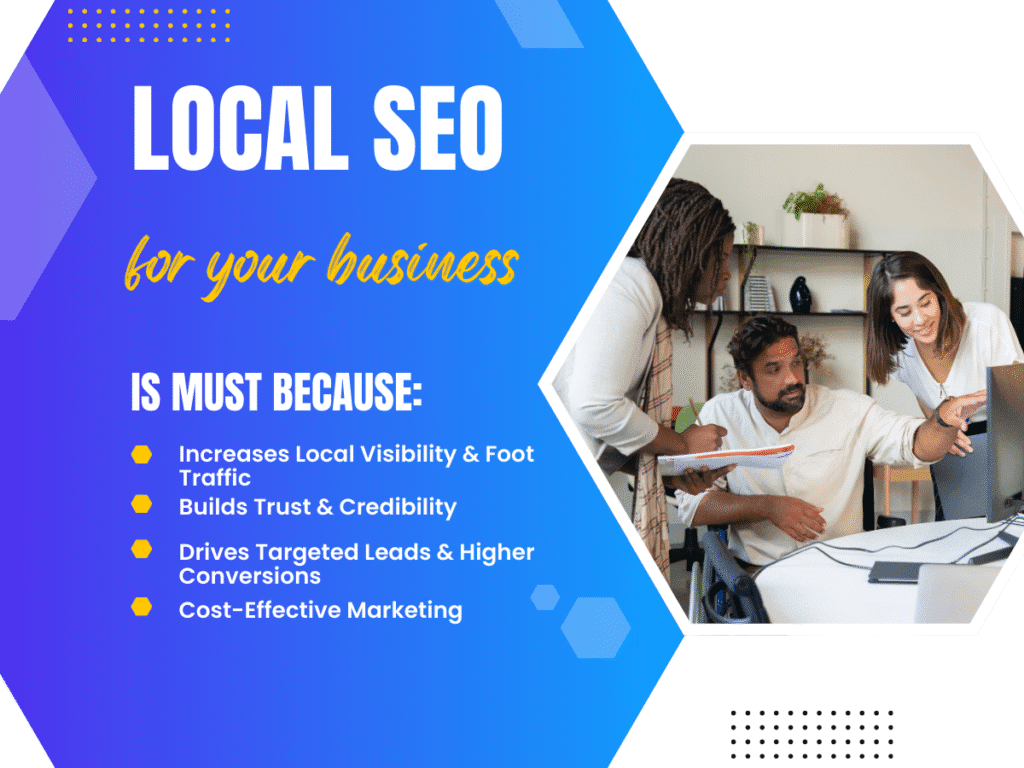If you run a business that depends on your community—like a café, dental clinic, law firm, gym, or even IT services—appearing on local search results is non-negotiable. People rarely flip through directories now; they simply type into Google and pick from what shows up near them. That’s why understanding local SEO is essential. This local SEO guide will show you step-by-step how to rank in local search and bring more customers straight to your door.
Table of Contents

Why Local SEO Matters
Imagine you run a small café in Sydney. When someone nearby searches “best coffee near me,” you’d want your café to pop up before the big chain down the street. If your business doesn’t appear in local search results, you miss out on highly motivated customers ready to visit that same day. Local SEO makes sure Google connects local intent with businesses like yours.
Step 1: Optimize Your Google Business Profile
Your Google Business Profile (GBP) is like your online storefront. It tells search engines—and customers—who you are, where you’re located, and what you do.
What to do:
- Claim and verify your Google Business Profile.
- Add accurate Name, Address, and Phone (NAP).
- Select accurate business categories.
- Upload high-resolution images of your business, staff, or products.
- Post updates about offers, events, or news.
Pro tip: Local searches rely heavily on GBP. For example, if you’re a dentist in Melbourne and your profile shows multiple reviews, updated hours, and friendly photos, you’ll likely be chosen over a competitor with little or no details.
Step 2: Ensure NAP Consistency Everywhere
Your Name, Address, and Phone (NAP) need to be the same across all platforms. If your business phone differs on your website, Facebook page, or Google listing, Google gets confused—and confusion hurts rankings.
Action checklist:
- Audit all your online profiles (website footer, social media, Yelp, directories).
- Correct any typos or outdated info.
- Keep everything 100% consistent.
It might feel minor, but think about it this way: if Google isn’t sure which contact info is correct, why should it confidently recommend you to searchers?
Step 3: Optimize Your Website for Local SEO
Beyond Google Business Profile, your business website plays a huge role in gaining visibility.
Tips for local optimization:
- Include your city or suburb naturally in meta titles, descriptions, and headers.
- Have a dedicated Contact page with your Google Map embedded.
- Write blog posts targeting community-related topics. Example: “Top Things to Do in Parramatta This Weekend.”
- Use schema markup to highlight local business info for search engines.
Real-world example: A hair salon in Brisbane added location-specific blogs like “Best Hairstyles for Brisbane Summer” and started ranking high locally within months.
Step 4: Collect and Manage Reviews
Reviews have an impact on local search rankings in addition to prospective clients. Google wants to promote companies that have received consistent favorable reviews.
What to do:
- Ask happy customers to leave reviews on your Google profile.
- Reply politely to every review—good or bad.
- Avoid fake reviews; Google can detect them.
Remember, when people see 50 positive reviews versus a competitor’s 5, they feel safer choosing you.
Step 5: Build Local Backlinks
Backlinks from local sources strengthen your authority. Google looks at them as votes of confidence for your business.
Ways to build quality local backlinks:
- Get listed on the websites of nearby charities or organizations by partnering with them.
- Submit your business to reputable online directories (TrueLocal, Yellow Pages, Yelp).
- Do local PR—sponsor events, collaborate with nearby businesses, and ensure your website gets mentioned.
For instance, a fitness trainer in Perth sponsored a local sports meet. The local newspaper featured them online with a link to their site, instantly boosting their visibility.
Step 6: Make Your Website Mobile-Friendly
More than 60% of local searches come from mobile. If your site is slow or hard to navigate on a phone, visitors will leave, and Google will notice.
How to fix it:
- Use responsive design.
- Compress images to speed up loading.
- Test user experience on different mobile devices.
Think of it: someone walking on the streets of Adelaide searching “Italian restaurant near me” won’t wait for a clunky site to load.
Step 7: Focus on Local Content
Creating content targeted at your community helps you connect with locals and rank better.
Content ideas:
- Blog posts about local news or events.
- How-to guides tied to local needs (e.g., “How to prepare for summer storms in Queensland”).
- Customer stories or case studies from your area.
This shows Google—and your community—that you’re not just any business; you’re their local choice.
Step 8: Use Social Media for Local Reach
Social signals indirectly help SEO. Active engagement on Facebook, Instagram, or LinkedIn can build awareness and strengthen your presence.
- Post behind-the-scenes photos.
- Tag your location often.
- Engage with local hashtags.
This builds trust and familiarity, which influence search behavior and clicks.
Step 9: Track and Adjust
SEO is not a “set and forget” game. Monitor progress to see what’s working and fix what’s not.
Tools to use:
- Google Analytics: Track website traffic.
- Google Search Console: See search queries bringing visitors.
- GBP Insights: Check how customers find your profile.
Example: If 70% of clicks come from “IT services Brisbane,” then doube down and optimize even more keywords for Brisbane-specific services.
Final Thoughts
Ranking in local search is not luck—it’s strategy. By following this local SEO guide, you’ll know how to rank in local search results:
- Set up and optimize your Google Business Profile.
- Maintain NAP consistency.
- Optimize your website for both content and speed.
- Actively collect reviews.
- Build local backlinks and create local-focused content.
The truth is, local SEO is less about outsmarting search engines and more about showing up consistently, being trustworthy, and staying visible in your community. Do these right, and your business won’t just rank higher—it will feel like the obvious choice for people nearby.
1. What is Local SEO and why is it important for small businesses?
Local SEO helps businesses appear in search results when people nearby look for products or services. It’s crucial for small businesses because it targets local customers who are ready to buy.
2. How long does it take to see results from Local SEO?
Typically, results start showing within 3–6 months, depending on competition, consistency, and how well the strategies are implemented.
3. Do reviews really affect local search rankings?
Yes! Google values reviews as social proof. A business with frequent, positive reviews is more likely to rank higher and attract clicks.
4. Can I do Local SEO without a website?
You can still rank with a Google Business Profile, but having a website gives you more credibility, control, and ranking potential. Together, they work stronger.
5. What’s the difference between SEO and Local SEO?
SEO focuses on ranking a website for global or national keywords, while Local SEO targets searches in a specific area—helping you attract nearby customers.
